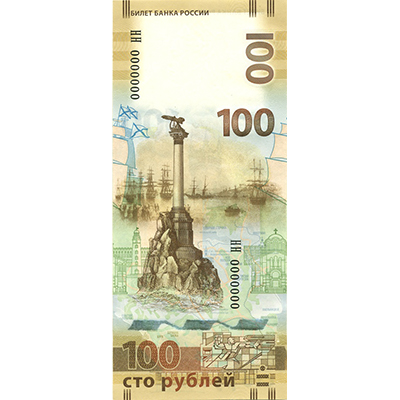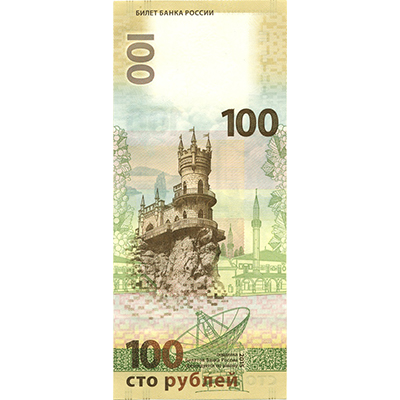The 100-ruble Bank of Russia commemorative banknote of 2015
The commemorative banknote is devoted to the accession of Crimea to the Russian Federation and establishment of new subjects of the Russian Federation: the Republic of Crimea and the federal city of Sevastopol.
 |
 |
One side of the note features the city of Sevastopol, the other one depicts Crimea.
The main image of the banknote’s side featuring the city of Sevastopol is the Monument to the sunken ships in the Sevastopol bay; in the background there are: a detail of the painting “Russian squadron on the Sevastopol roads”, the layout of Sevastopol, outline pictures of landmarks and historical monuments. In the lower part of the banknote there is a picture detail of the Memorial devoted to the heroic defense of Sevastopol in
The main image of the banknote side featuring Crimea is the architectural monument “Swallow’s Nest”; in the background there are: the cliff “Sail” and the mountain Au-Dag, outline picture of the Khan’s mosque in Khan’s Palace in Bakhchysarai; in the lower part of the banknote there is an image of the radio telescope RT-70; along the left and the right edges of the banknote there is a contour image of vine.
 |
Catherine the Great was Russian empress from 1762 till 1796. Under her rule Russia took a dominant position on the Black sea coast and developed its new territories in south regions of Russia. With the formal proclamation dated April 8, (April 21) 1783, Catherina II settled the accession of the Crimean Peninsula to the Russian Empire “...to access to Our Empire the Crimean peninsula, the Taman island and the whole Kuban region”. Less than one year later she issued a decree dated February 10, (February 23) 1784, ordering to build “a large fortress Sevastopol, at the same place where nowadays Achtyjar is situated. In the new fortress there should be the Admirality, the shipbuilding yard for ships of the first rank, a harbor and a military settlement”. The prototype of the banknote’s watermark is a side-face picture of Catherine II by VigiliusEriksen, a Danish painter. The picture is nowadays kept in the State Hermitage. |
 |
The Monument to the sunken
ships — is a memorial in Sevastopol bay devoted to sailing ships,
which were sunk in |
 |
The Memorial to the heroic
defence of Sevastopol in |
 |
The Swallow’s Nest is a decorative castle built on a small plot of the Aurora Cliff in 1912. It was designed by the Russian engineer and sculptor Leonid Sherwood. Because of its beauty and original style the Swallow’s nest became one of the most popular visitor attractions and the symbol of the Crimean peninsula. |
 |
The Big Khan Mosque — is one of the largest mosques in Crimea and one of the first buildings of the Khan’s palace. It was built in 1532 by Sahib I Giray and bore his name in the 17th century. This is a massive building with an ogival arcade and majolica decorative elements on the walls. The Mosque has two octagonal minarets with conical caps decorated with bronze crescents. Each minaret is 28 meters high. |
 |
The radio telescope RT-70, with its 70m antenna diameter, is among the largest radio telescopes in the world. It was built near the town of Yevpatoria in 1978. Besides fulfilling ordinary radio astronomic functions in observing intrinsic emission of celestial bodies, the telescope complex disposes over powerful senders, which allow active space experiments, connected with sending powerful electromagnetic flows. |
 |
The St. Vladimir’s Cathedral in Sevastopol is a historical and architectural sight, built in the neo-byzantine style on the petition of Russian admiral Mikhail Lazarev. The project was made by architects Konstantin Thon and AlekseyAvdeyev. The building rises to a height of 32.5 meters. The crypt, which was in the place of the later built Cathedral, already contained tombs of admiral Mikhail Lazarev as well as Vice-Admiral Vladimir Kornilov, Rear Admiral Vladimir Istomin and Admiral Pavel Nakhimov, who died in the Crimean war. |
Sources:
The complete collection of the Laws of the Russian Empire, volume XXI, Nr. 15.708
The complete collection of the Laws of the Russian Empire, volume XXII, Nr. 15.929
http://www.ru.wikipedia.org
http://poluostrov-krym.com
